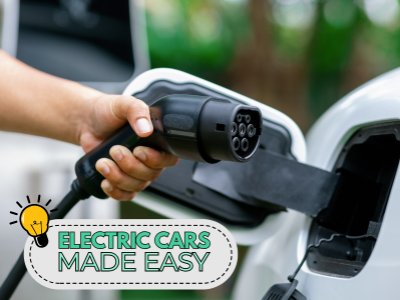
28 May 2025
Electric Cars Made Easy: A Beginner’s Guide to Driving an EV
Ready to drive electric? EVs are simple to use—just sit, select Drive, and go. With quiet motors, smooth acceleration, and energy-saving features like regenerative braking, driving electric has never been easier.
Making the switch to an electric vehicle can be exciting, but it also comes with a few new things to learn. From understanding how far your car can go on a single charge to using smart features that help save energy, getting familiar with these basics will make your driving experience smoother and more enjoyable. Whether you’re new to EVs or just looking for some handy tips, here’s a simple guide to help you get the most out of your electric car.
- Charge During Off-Peak Hours
Charging your car overnight or during off-peak electricity might lower your energy costs, depending on your provider. However, avoid charging for longer than necessary to save both time and energy. - Switch Off Unnecessary Accessories
Modern EVs come packed with tech and comfort features, but these can drain your battery if left on unnecessarily. Turn off seat warmers, extra lighting, and other accessories when you don’t need them to maximise your car’s energy efficiency. - Ease Up on the Accelerator
Electric motors deliver power instantly, so acceleration can be surprisingly quick. To maintain smooth control and conserve energy, apply gentle pressure to the accelerator rather than flooring it. - Monitor Your Battery Level Closely
Unlike fuel gauges in petrol cars, EVs usually have battery indicators similar to those on phones or laptops. Keep a regular check on your battery percentage, especially during longer trips, to avoid running low on power unexpectedly. - Utilise Regenerative Braking
Electric vehicles often feature regenerative braking, which helps slow the car without using the brakes. This system recovers energy during deceleration, especially when coasting or descending hills, and feeds it back into the battery, helping you extend your driving range. - Unplug Once Fully Charged
Just like you wouldn’t keep a petrol pump nozzle attached after filling your tank, avoid leaving your EV plugged in after it’s fully charged. Doing so wastes electricity and money, and it’s also less environmentally friendly. - Make the Most of Your EV’s App
Most electric cars come with a dedicated smartphone app that lets you control many functions remotely. Plan journeys, and even pay for charging, all from your phone. - Pay Attention to Weather Conditions
Weather can impact your EV’s battery performance. Cold temperatures often reduce battery life, so keep an eye on your charge when it’s chilly. Similarly, very hot weather can affect lithium-ion batteries, so monitor your battery level closely during heatwaves to avoid surprises. - Know Your EV’s Driving Range
If you’re new to electric vehicles, the first thing to understand is how far your car can travel on a single charge. Different EV models offer different ranges, so it’s important to check this before you buy or rent. Planning your route around available charging stations will help ensure you don’t run out of battery power during your trip. - Remember EVs Are Quiet
Electric cars operate almost silently, which might feel strange at first. Don’t try to “rev” the motor as you would with a petrol car, just trust the smooth, quiet power delivery of your EV.


